Challenging Times Require Challenging Art

Matthew VanBesien in Nickels Arcade, with the 2017-18 UMS No Safety Net brochure. Photo by Jesse Meria.
When I was announced as the new president of the University Musical Society (UMS) at the University of Michigan a year ago after five years as president of the New York Philharmonic, some people thought I was crazy. Why on earth, they asked, would a former professional musician and successful orchestral executive who led three different major orchestras on two continents want to move to a relatively small university town in the Midwest?
Certainly the chance to come to one of America’s most charming and livable cities, to collaborate with one of the best research universities anywhere, and to work with an intellectual and culturally adventurous populace were all important factors.
But another answer for me was something quite potent and simple, and that I know will continue to define our work at UMS moving forward. Coming to UMS offered artistic diversity as a performing arts presenter (not just music, but also dance and theater — and maybe much more), but also the latitude to think more broadly about the arts as a vehicle for both cultural and social change. We are now at the end of a three-week theater festival titled “No Safety Net,” using theater and creativity as catalysts for exploring viewpoints that we, as individuals and as a community, long to understand better.

Program cover for “No Safety Net”
This is no easy time for university campuses across the nation, including ours, where the community is grappling with how to respond to a speaking request from a white supremacist who slyly foments protests with hateful words and singular ideas; where students have encountered racist flyers and ethnic slurs in prominent locations on campus; and where issues of identity, gender equality, and sexual harassment are ever-present.
And, of course, these issues transcend the public university environment and are symptomatic of larger cultural divisions, threatening to engulf our entire society with mistrust, anger, and fear.
But as artistic leaders, we have the privilege—and the imperative—to help change that.
A few weeks before his death, President John F. Kennedy spoke at Amherst College, at an event honoring the late poet Robert Frost. He spoke of art serving as a touchstone of our judgment as humans, noting that “We must never forget art is not a form of propaganda; it is a form of truth…If sometimes our great artists have been the most critical of our society, it is because their sensitivity and their concern for justice, which must motivate any true artist, makes [them] aware that our Nation falls short of its highest potential.”
As a performing arts institution, and as a major public university, we endeavor to help people understand the breadth of the human experience and to reach our highest potential. This comes about by creating an environment for courageous conversations across areas of commonality — and difference.
In an increasingly polarized world, it’s tempting to take complicated issues and turn them into reductive problems that lack both substance and nuance. But as the American actress and playwright Lisa Kron has said, “If there’s only one point of view, there’s no drama. Drama only occurs when people come up against situations outside of themselves and are changed by them.”
As someone leading an arts institution, I can no longer ignore the imperatives for social consciousness, for empathy, and for moving beyond superficial representation and into meaningful and substantive dialogue. One of the most powerful pathways for doing so is to engage with culture and creativity, embracing free speech and an unfettered exchange of ideas.
These imperatives are manifesting themselves with increasing frequency — Robin Bell creating protest art against President Trump’s immigration policies, and Oskar Eustis’ production of Shakespeare’s Julius Caesar at the Public Theater causing a stir last summer with Caesar styled as a present-day Donald Trump.

The cast of Hamilton addresses Vice President Pence. Photo courtesy of Twitter.
And last year, shortly after the election, Vice Present-elect Mike Pence attended a production of Hamilton and was admonished by the cast to work on behalf of all of “the diverse America who are alarmed that your administration will not protect us, our planet, our children, our parents, or defend us and uphold our inalienable rights.”
Shortly afterwards, President Trump demanded an apology, tweeting, “The theater must be a safe and special place.” Special? Absolutely. Safe? Maybe. Maybe not.
At UMS, we took an alternate approach, purposely calling our concentrated theater festival “No Safety Net” to signal that we are intentionally placing major societal issues on the table: slavery and race in America, terrorism and acts of violence, non-binary gender identity, and recovery from addiction and depression.
We programmed this festival for those eager to engage with some of the thorny issues of our time. But it’s also intended for those who are hesitant, or even anxious, about doing so, providing an honest but nurturing environment for civil discourse. What happens off the stage during No Safety Net is as important as what happens on it, with many opportunities to spark and facilitate debate around the relevant, interesting, and sometimes troubling issues contained therein. While sometimes controversial, the four theatrical works on stage provide a concentrated period for both reflection and action, bringing people together to think about how we move forward as institutions, as a country, and as a global society.
No Safety Net asks us to embrace complexity and ambiguity—the artists we are hosting provoke thinking that can unsettle, challenge, entertain, but also hurt. At the same time, tackling these issues through their artistic lens has the real possibility to expand our own thinking as audiences, granting us both the intellectual and emotional space to consider others’ points of view.
When we step back and remember that one person’s provocation may be another person’s reality, we are also reminded that it behooves all of us to move out of the echo chamber and expose ourselves to environments where people may disagree with us.
Our communities will once again thrive upon returning to the basic tenets of our democracy — respect, decency, and a commitment to both seeking, and acknowledging, truth. The University of Michigan and the University Musical Society believe the arts are uniquely positioned, now more than ever, to help us with this journey.
Matthew VanBesien has been president of the University Musical Society at the University of Michigan, a 2014 National Medal of Arts recipient now in its 139th season, since July 2017. He has previously served as president of the Houston and Melbourne Symphony Orchestras and the New York Philharmonic.
Behind the Scenes: University of Michigan Students Perform with New York Philharmonic
As part of the UMS residency with New York Philharmonic, Jamie and Jessica, students from the U-M School of Music, Theatre & Dance, performed on stage with the orchestra at Hill Auditorium.
Go behind-the-scenes from audition to performance in this video.
Learn more about the 2017-18 season concerts and residency experience.
Behind the Scenes: 2017 New York Philharmonic Visit in Photos
As part of the 2017-18 UMS season, the New York Philharmonic visited Ann Arbor for three concerts and many educational residency activities in November 2017. Here are some of our favorite photos captured during the residency.
- NY PHIL Off The Grid pop-up chamber concerts took place downtown Ann Arbor at Fred’s and Avalon.
- Percussion musicians at Fred’s.
- In the audience.
- Musicians at Avalon.
- In the audience.
- Hill Auditorium, lit up for the concerts.
- New York Philharmonic on stage.
- U-M president Mark Schlissel and UMS president Matthew VanBesien speak from the stage.
- Students at U-M School of Music, Theatre & Dance await master classes with musicians from the New York Philharmonic.
- At a master class.
- Conversation between UMS president Matthew VanBesien and New York Philharmonic President Deborah Borda at the Ross School of Business.
- Leondard Slatkin and Barbara Haws during a pre-concert lecture.
- A full house during a pre-concert lecture.
- Kids learn more New York Philharmonic musicians before the concert recreating Leonard Bernstein’s Young People’s Concerts.
- Mark Schlissel, Leonard Slatkin, Matthew VanBesien, Jeremy Irons, and Rosie Jowitt at the Victors for the Arts gala.
- String quartet at the Victors for the Arts gala.
- At the Victors for the Arts gala.
- Leonard Slatkin at the final concert of the residency.
- Jeremy Irons narrates Leonard Bernstein’s “Kaddish” Symphony at the final concert of the residency.
Learn more and the New York Philharmonic concerts and residency experience.
Behind the Scenes: Off The Grid
UMS and the New York Philharmonic went Off The Grid for two pop-up concerts with New York Philharmonic musicians and University of Michigan School of Music, Theatre & Dance students at Avalon and Fred’s in Ann Arbor on November 16, 2017.
Full New York Philharmonic concerts and residency information.
Student Spotlight: Casey Voss with the New York Philharmonic and the NYU Music Experience Design Lab
Editor’s note: As part of the UMS 21st Century Artist Internships program, four students interned for a minimum of five weeks with a dance, theater, or music ensemble part of our 2017-2018 season. Casey Voss is one of these students. This summer, he was embedded with the New York Philharmonic.
Below, Casey shares his travel stories with the orchestra in advance of the New York Philharmonic’s return Ann Arbor for three concerts and many residency activities November 17-19, 2017.
Over the course of my internship I worked alongside two arts organizations: the NYU Music Experience Design Lab (MusEDLab) and the New York Philharmonic Archives Department. I was thrilled to be involved with two groups that make a tremendous impact on a global scale. MusEDLab is involved in a wide spectrum of projects, including creating interactive digital content to facilitate music education for children. In addition to being a world-renowned orchestra, the New York Philharmonic is responsible for extensive outreach projects for early education and community engagement.
I spent the first week of my internship exploring some of the projects that the MusEDLab had been developing. Groove Pizza is a fun space for children effortlessly write their first beat using colors and shapes. Projects in collaboration with the Philharmonic included the various Variation Playgrounds where the user recomposes such classics as Dvořák’s Ninth Symphony, Mendelssohn’s A Midsummer Night’s Dream, and Britten’s Young Person’s Guide to the Orchestra. MusEDLab also creates more research-driven content, such as “Mahler Grooves,” an interactive platform that allows users to explore Mahler’s Sixth symphony with multiple scores and recordings synced in real time.


Photos: On Left, group photo of Guitar Mash NYC’s first-ever youth event, hosted by MusEdLab at NYU Steinhardt. This program is an incredible opportunity for young songwriters and beginners to come together and share their music. On Right, MusEdLab explores their latest analytics data at their weekly “sync meeting”.
Meanwhile, I made my first visit to the New York Philharmonic Archives. I was introduced to director Barbara Haws who gave me the 30-second tour of of an incredibly dense office space. Being surrounded by Grammy awards, Gustav Mahler’s baton, and countless volumes of historic documents sent me straight to music-nerd heaven. After introductions were out of the way, she set me behind a computer screen with the complete volume of Leonard Bernstein’s Young People’s Concerts (YPCs) and said, “go!”
I was immediately overwhelmed at the scope of this content. There were so many episodes––53 to be exact! As alluring as it may have seemed, I wasn’t prepared to sit in a fancy chair and watch T.V. for the next 53 hours. I quickly realized that there was a need for a better way to navigate these programs, but I wasn’t quite sure what that would entail.
The technology that I had witnessed at the MusEDLab continued to settle in my brain. That evening on the 2 train I had my “Eureka!” moment, relating directly to the “Mahler Grooves” platform that I had encountered days before. What if the technology that allowed users to toggle between different scores and recordings could be applied to the various scripts and musical cues concerning the YPC episodes? This tool would streamline the research process, allowing users to spend more time making connections with the data and less time sifting through the content.


Photos: On left, Alex Ruthmann (right) and I pose for a photo during the final week of my internship. On Right, a sunny day in front of Alice Tulley Hall at Lincoln Center.
That evening I excitedly drafted a one-page proposal of what this project entailed. I sent it to Alex Ruthmann, my mentor and primary contact at MusEDLab. He took me under his wing and guided my creative process from scratch. Much of what he suggested required that I learn to code in HTML, CSS, and Javascript—three languages for which I was unfamiliar. I spent several days crash-coursing them and trying to decipher how they were meant to work together to build a web page. Though this process was tedious I managed to craft a webpage that consisted of properly aligned-text and a picture of Leonard Bernstein (which is much trickier than what you might think!).
Equally as as gratifying was the fantastic time I was having exploring New York City. There was plenty of time to visit museums, eat pizza slices the size of my face (or larger), and attend as many shows as possible. Observing the New York Philharmonic’s rehearsal of Mahler’s Seventh Symphony in David Geffen Hall was one of the highlights of my visit. Seeing a world class ensemble perform some of the most gut-wrenching repertoire at 9 am on a Thursday really put things into perspective.


Photos: On left, enjoying a Super Slice at the Pizza Barn in Yonkers, NY. On right, a view from an empty lobby in David Geffen Hall as the New York Philharmonic prepares for a rehearsal of Mahler’s Seventh Symphony.
I made many new friends both inside and outside of the internship as well. Some of these friendships began at the Music and Mentoring House (MMH), a brownstone walk-up in Harlem where I lived for six weeks. Hosted by American Operatic Soprano Lauren Flanigan, MMH provided all of the basic needs for artists interning in the city. Lauren cooked, cleaned, and told us incredible stories from her illustrious career. Her generosity eased our anxieties and allowed us to remain focused on finishing our projects. I’m grateful for the opportunities that Lauren created for us to escape the chaos of city life.


Photos: On the left, Sandbox Percussion Quartet takes the stage at the hip Brooklyn rooftop bar simply known as “The Roof” on the final evening of my internship. On the right, taking it easy after a hard-day’s work on the Hybar Pavilion, a twisting grass canopy located on the rooftop of the Film Society of Lincoln Center.
Since leaving New York, I’ve kept in touch Alex and Barbara, continuing to refine the project for a collaborative course between Harvard College and the University of Michigan. Students in this class are investigating the impact that Leonard Bernstein’s Young People’s Concerts have had on his audience. One of the most rewarding aspects of this internship was creating something designed to make other’s lives easier. This project was my first opportunity to present and execute an idea for which I had total creative control. Alex guided my work, but our dynamic was unlike that of a typical teacher-student relationship. All of these factors coming together granted me a real-world experience—a tangible achievement that impacts the lives of other people. As I transition from school to the professional world, this 21st Century Artist Internship has given competitive edge in an ever-evolving artistic landscape.
The New York Philharmonic performs in Ann Arbor November 17-19, 2017.
How to Win Fans and Influence (Young) People
Editor’s note: The New York Philharmonic recreates a Young People’s Concert on November 18, 2017. In this post for UMS, Doyle Armbrust, a Chicago-based violist and member of the Spektral Quartet, writes about broadcasts of Leonard Bernstein’s Young People’s Concerts from 1960–1972.
Back in my freelancing days, I played in an orchestra with a gambling problem.
No, not March Madness brackets or Fantasy Football drafts. These bets surrounded the conductor, and one element of his time atop the podium each concert. Actually, the bet was about just that: his time on the podium. This conductor was notorious for delivering the longest, most meandering pre-performance soliloquies any of the musicians had ever been subjected to, and the most epic of these during my tenure clocked in at…wait for it…just over 40 minutes.

Students waiting to purchase tickets to the Leonard Bernstein Benefit Concert in Ann Arbor on October 10, 1988. Photo from UMS Archives.
These exhaustive (and thoroughly exhausting) preambles were ostensibly for the benefit of the audience, to deepen their understanding and enjoyment of the music, you understand. Though capable with his baton, this Chatty Cathy in tails somehow lacked that one, essential social skill: recognizing the moment an entire concert hall and all the musicians on stage have simultaneously glazed over as though auditioning for The Walking Dead, en masse.
The one-two punch of this verbal anesthesia was 1) The orator appeared more infatuated with his own factoids than the experiential welfare of his hostages, and 2) Condescension permeated the delivery to such an extent that “mansplaining” doesn’t quite capture it. This was “splain-splaining.”
The thing is, classical music already has a(n image of) superiority problem. Which is to say, the uninitiated largely assume that those of us who seek this music out have participated in Ken Burns-level research on the subject and undergone extensive training with Clint Eastwood to perfect the glare reserved for mid-symphony clappers. The truth of the matter is that it’s familiarity that emboldens and vitalizes our love of these pieces, not the ability to identify augmented-sixth chords on the fly.

Leonard Bernstein. Courtesy of the New York Philharmonic Leon Levy Digital Archives.
Familiarity is something with which my conductor was unconcerned. It is also something Leonard Bernstein cultivated in perhaps his most enduring legacy, the Young People’s Concerts of 1960–1972.
I am of the opinion that these broadcasts are more important than any of the conductor-composer’s many recordings, his Beethoven’s Ninth Symphony at the Berlin Wall, or his Mahler at President John F. Kennedy’s funeral. He snagged a CBS prime time slot for three of his 13 seasons, for crying out loud. But why do I, and maybe you, and so many of my professional contemporaries remember with such relish a parent bringing home these VHS tapes from the library? Why are the segments uploaded to YouTube littered with the delicious pangs of nostalgia for these presentations? (Personal favorite: “Grew up on this. Sigh. Better than ANY college Music 101 course anywhere ever.”)
I think Bernstein’s approach to music advocacy and enlightenment can be best summed up in his narration to Prokofiev’s Peter and the Wolf (CBS Great Performances, 1982). Departing from the usual introductions to the cat/bird/duck/wolf/grandfather themes, Bernstein poses each audio snippet as a pop quiz, congratulating the listener with, “Right again!,” and, “You’re batting a thousand!” There is empowerment and affirmation in his belief in your knowledge, and a gentle expectation that you’ll be back for more.

Leonard Bernstein and kids. Courtesy of the New York Philharmonic Leon Levy Digital Archives.
This familiarity with the audience and conversational delivery is all over the Young People’s Concerts, from the grainy black-and-white films of the early 1960s up through the groovy color broadcasts (and neckties) of the early 1970s. Even the title suggests a level of maturity lacking in many or most of the kid-centered events I’ve come across in concert halls around the US.
Bernstein didn’t play it safe in these shows, either. “The Genius of Paul Hindemith” sounds like the punchline to an undergrad viola joke, given how under-appreciated the composer (and champion of the viola) continues to be. And yet, in this episode, Bernstein pulls apart the right and left hands of the Three Exercise Pieces for piano to illuminate the concept of cross-relationships and poly-tonality. These are not concepts most civilians will be aware of, but by drawing a parallel to Bach’s Two-Part Inventions, what was opaque becomes transparent. It is a discovery, an unveiling…not a lecture.
Have you ever experienced that oh-so-cringe-y moment at a kids’ concert, when the speaker attempts to update the themes of the music with a tenuous reference to pop culture? Kill me now. Bernstein, though, so genuine in his love for the symphonic repertoire and eager to share why, manages to equate the psychedelia of Berlioz’s Symphonie Fantastique with that of the Beatles without ever slipping into the aforementioned pandering. “[It’s] the first musical description ever made of a trip…” the conductor tells the 1969 audience.
If decades have elapsed since you last watched one of these brilliant broadcasts, let me assure you that not only do they hold up exceedingly well — there is even more to be mined in watching them as an adult. I found myself gasping while watching the “Who Is Gustav Mahler” episode, having recently read a collection of Bernstein’s personal correspondences in which his wife, the Chilean actress Felicia Montealegre, writes: “I am willing to accept you as you are, without being a martyr or sacrificing myself on the L.B. altar.” This letter is of course in reference to Bernstein having told Montealegre that he was gay, and watching his passionate description of Mahler (a far lesser-known composer in 1960, when the piece aired) as a man living two disparate lives, simultaneously, is simply heartbreaking.

Leonard Bernstein meets with students at the Leonard Bernstein Benefit in Ann Arbor in 1988. Photo from UMS archives.
This essay isn’t about pining for “the good old days,” though. For instance, a scan of the New York Philharmonic musicians in these videos reminds the viewer just how monochromatic, and what a “bro-down,” was the roster. And to be fair, the Young People’s Concerts landed its primetime slot in large part because the FCC had its undies in a bundle about the lack of wholesome programming. What Bernstein did better than anyone before or since, though, is to make the sharing of musical knowledge a centerpiece, rather than a side-hustle, of his time at the helm of the New York Philharmonic. Add to that an irrepressible desire to share his enthusiasm and delight in this music, and you have a legacy that defies the Cocker Spaniel-esque attention span of history.
P.S.: If you’re hungry for something new in the vein of the Young People’s Concerts, check out the TED Talk by Bernstein’s protégé, Michael Tilson Thomas, and then chase down his excellent Keeping Score series.
Doyle Armbrust is a Chicago-based violist and member of the Spektral Quartet. He is a contributing writer for WQXR’s Q2 Music, Crain’s Chicago Business, Chicago Magazine, Chicago Tribune, and formerly, Time Out Chicago.
The New York Philharmonic returns to Ann Arbor for concerts and residency activities November 17-19, 2017.
Call for Stories: New York Philharmonic

Photo: Leonard Bernstein with young people. Photo courtesy of New York Philharmonic Leon Levy Digital Archives.
Faculty and students from the University of Michigan, New York University, and Harvard University are collaborating on a cross-campus initiative to archive stories of audience members who experienced Leonard Bernstein’s Young People’s Concerts as children.
If you experienced Leonard Bernstein’s Young Peoples’ Concerts in your youth, either live or on television, we invite you to participate in an interview regarding the impact these events had on your musical life. The University of Michigan’s “Music in the U.S.” course is joining forces with the New York Philharmonic Archives for this oral history project, and interviews will be held in both New York City and Ann Arbor.
If interested, please email Professor Jessica Getman at jgetman@umich.edu; interviews will be scheduled around the weekend of the New York Philharmonic’s residency in Ann Arbor, November 17–19, 2017.
UMS/New York Philharmonic Residency: By the Numbers
UMS’s residency with the New York Philharmonic in October 2015 touched unprecedented numbers of people through performances, master classes, educational activities, and the halftime show at the U-M Homecoming Football game against Northwestern.
A highlight reel of the weekend’s activities:
Performances
The New York Philharmonic gave performances of three different programs in Hill Auditorium October 9-11, 2015. Total attendance was 7,945 across all three performances . First-time UMS ticketbuyers accounted for 38% of the total audience. Attendees came from 37 states plus the District of Columbia, and from 8 foreign countries.
Student Attendance
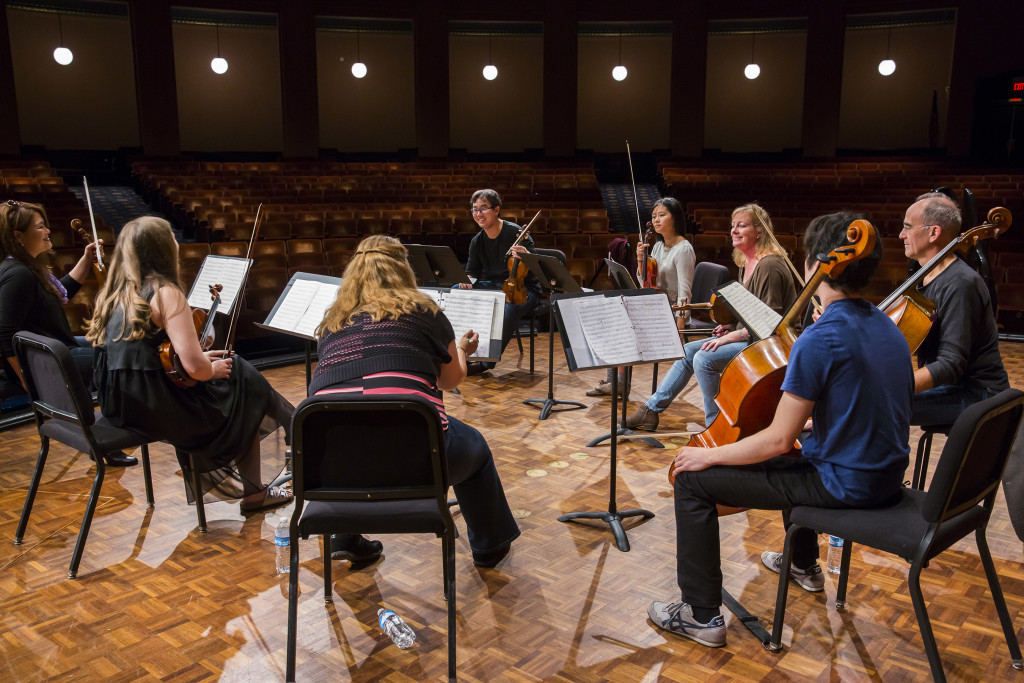
New York Philharmonic at Univeristy of Michigan, Ann Arbor Residency, 10/08/15. Photo by Chris Lee
Students purchased more than 2,250 tickets at a significant discount and accounted for nearly 30% of paid attendance. UMS subsidized over $110,000 in discounted tickets for students. In addition, students accounted for an estimated 75% of those attending the various residency activities over the course of the multi-day residency.
Residency Activities
As part of the multi-day residency, members of the New York Philharmonic participated in 36 additional public and private activities, including lectures by various Philharmonic staff (5); a side-by-side chamber music concert (and rehearsal) in which New York Philharmonic principal musicians played alongside U-M School of Music, Theatre & Dance graduate students (2); classroom visits (5); master classes and conducting roundtables (17); visits to three Ann Arbor high schools (4); an event pairing medical students with Philharmonic musicians (1); an open rehearsal for conducting students (1); and performing at the U-M Hospital as part of the Gifts of Art program (1). The total reach of these activities was 2,495.
In addition, UMS selected U-M student and percussion major Evan Saddler as part of its 21st Century Arts Internship program, and he was placed as an intern with the New York Philharmonic for the summer leading up to the residency. He writes about his experiences on this blog.
Half-time with the New York Philharmonic Brass and the U-M Marching Band

New York Philharmonic at Univeristy of Michigan, Ann Arbor Residency, 10/10/15. Photo by Chris Lee
One of the highlights of the residency was the inclusion of the New York Philharmonic brass section in the University of Michigan Homecoming Football game halftime show, along with the U-M Marching Band, the U-M Alumni Band (a Homecoming tradition), and the UMS Choral Union. Alan Gilbert conducted the 1,000+ musicians in selections from Aida, Bolero, Carmen, Beethoven’s Ninth Symphony, and other works. Total game attendance was 110,452, and the video of the halftime show has received tens of thousands of additional views.
The “digital Big House” resulted in nearly 200,000 people engaged through social media platforms, including Facebook, Twitter, Instagram, and umslobby.org. The 9 videos that UMS produced during the course of the residency received almost 50,000 views over the course of the weekend.
Eugene M. Grant
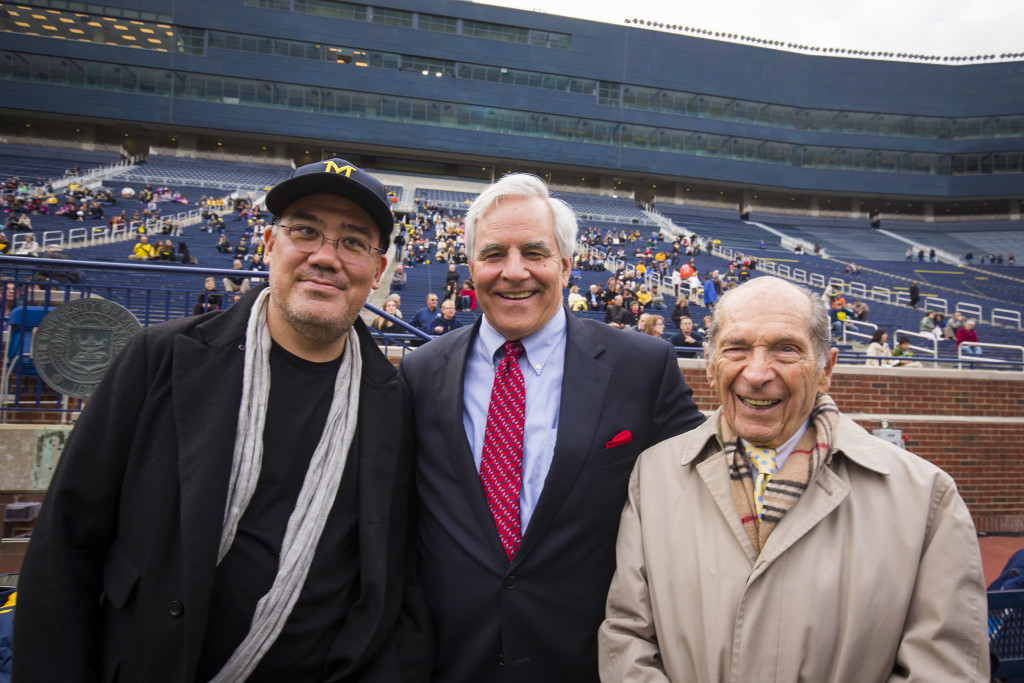
New York Philharmonic at Univeristy of Michigan, Ann Arbor Residency, 10/09/15. Photo by Chris Lee
The New York Philharmonic residency marked the first gift of $1,000,000 to UMS, from UMS National Council member Eugene M. Grant (’38, LSA). At 97, Mr. Grant came to Ann Arbor for the weekend’s activities and called it “one of the most memorable events of the past four decades.” Mr. Grant was celebrated at a special “Victors for the Arts” gala dinner on Thursday, October 8 on the stage of Hill Auditorium.
Members of the media interested in more information about the program should contact Sara Billmann, UMS Director of Marketing & Communications, at sarabill@umich.edu.
NY Phil at Schools
Last week, New York Philharmonic Assistant Conductor Joshua Gersen visited Huron High School and other Ann Arbor area schools as part of a 5-year partnership between the orchestra and UMS.
Interested in more? Explore more behind the scenes video moments with the orchestra on our Facebook page.
Highlights from the Field
On October 10, musicians of the New York Philharmonic took to the football field along side the U-M Marching Band at the Michigan vs. Northwestern Homecoming game.

Three concerts and a slew of activities were a part of the residency, which is part of a five-year partnership with the orchestra.
Interested in more? Watch the full halftime show over at U-M Athletics.
At the Victors for Arts Gala

Scenes from our Victors for Michigan gala dinner, a special event kicking off a weekend of concerts and residency activities with New York Philharmonic.
In center photo, UMS president Ken Fischer (left), University of Michigan president Mark Schlissel (right), and Eugene Grant, whose $1 million gift makes the residency possible.
Interested in more? Explore the full range of residency events and activities.
Student Spotlight: Embedded with New York Philharmonic
Editor’s note: As part of the UMS 21st Century Artist Internships program, four students interned for a minimum of five weeks with a dance, theater, or music ensemble part of our 2015-2016 season. Evan Saddler is one of these students. This summer, he was embedded with the New York Philharmonic.
Below, Evan shares his travel stories with the orchestra in advance of their return Ann Arbor for three concerts October 9-11, 2015 and many surrounding residency activities.
It was April 1, 2015 and I hadn’t heard back from UMS about the 21st Century Artist Internship. Despite the feeling that I had done well in the intense interview process (in front of a panel of eight core UMS staff members), I assumed that no communication meant that I hadn’t made the cut; thus I began to make other summer plans. Later that same evening however, a voicemail appeared in my inbox. It was one week old. The contents of this stale voicemail: Jim Leija, Director of Education and Community Engagement at UMS, was informing me that I would be moving to New York in less than a month’s time to intern with the New York Philharmonic. I contacted Jim right away, apologized for my tardiness, and accepted the offer diligently.

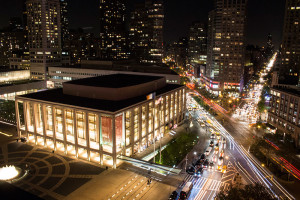
Photos: On left, lower Manhattan taken from the Manhattan Bridge. On right, a view from a rooftop looking down at Avery Fisher Hall at Lincoln Center, home of the New York Philharmonic.
My world went into chaos mode. The end-of-year to-do list was perpetual. I was finishing up classes and projects in Ann Arbor, preparing for exams, and performing my Junior Recital. And now I also had to find a place to live for six weeks in Manhattan, book the flights, and prepare for an experience of a lifetime. Also, I didn’t know exactly what I was getting into. I had a phone interview with my boss to-be, Vice-President of Artist Planning at the New York Philharmonic Ed Yim, followed by follow-up interviews with two members of his team. Thankfully, both phone interviews went smoothly, and I got the green light. I would have many more interviews to come, I discovered, and these interviews would become a crucial component of my internship.
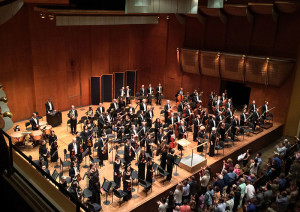
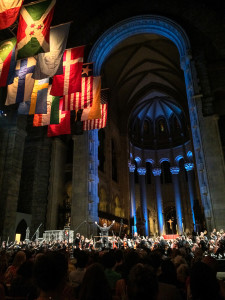
Photos: On left, after a performance of Brahm’s Symphony No. 4 with Manfred Honeck. On right, following a Memorial Day concert open to the public at St. John The Divine Cathedral on the Upper West Side.
The school year drew to a close, and I found myself transplanted to New York City. I was fortunate to be put in contact with the fabulous Lauren Flanigan, an operatic-soprano who has sung with the New York City Opera and the Metropolitan Opera. She runs a wonderful organization called the Music and Mentoring House. Lauren has created an incredibly supportive environment that caters to young artists studying, auditioning, and transitioning to living in New York City. She graciously took me in and allowed me to stay in her gorgeous Harlem walk-up brownstone townhouse for six weeks. She even cooked breakfast and dinner Monday through Friday for all of us living in the house. In addition, every Sunday evening before the work week began, all of us students living in the house, and some of Lauren’s close friends, colleagues, and neighbors gathered for what I called “family dinner”; a grill-out on the back patio (yes, in New York City) enjoying food and wine, discussing music, art, life, and one another’s company. It was always a highlight of my week. In addition to all of that, Lauren also set up a lesson for me with drummer Barry Altschul, one of Chick Corea’s early drummers. The entire situation could not have been better.
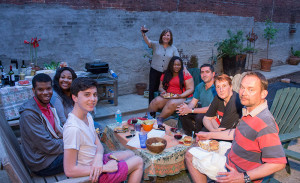
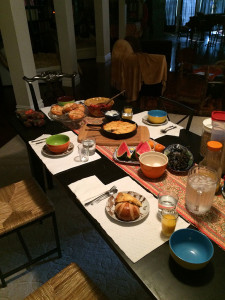
Photos: On left, family dinner, a weekly Sunday-evening tradition at Music and Mentoring House, which included grilling out and celebrating summer with new friends! On right, the goodness I woke up to before leaving for Lincoln Center; one could say we had it made at Music and Mentoring House.
I cherish the time that I had during my internship with the New York Philharmonic. I learned a great deal about the inner-workings of a world-class performing-arts organization, experience that will be invaluable to me moving forward. The extent of planning, precision of logistical execution, leadership, and effort on the part of everyone, on a daily basis at Avery Fisher Hall, is astounding. Most of this work is unseen by the average concertgoer. In addition to day-to-day administrative duties, I conducted formal and informal interviews with countless people within the New York Phil. The interviews helped me to see how component parts makes up the whole. Whether I was meeting with someone from the marketing department, the production team, the archivists, a musician in the orchestra, or the president of the organization, everyone was passionate about making a positive contribution to the forward momentum of the organization to ensure it’s longevity in the ever-changing 21st century’s musical and artistic climate.
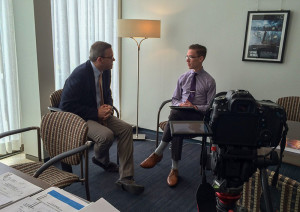
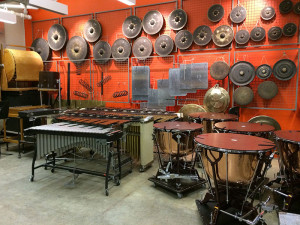
Photos: On left, taken during my video interview with President of the New York Philharmonic, Mr. Matthew VanBesien; the culmination of my series of interviews with people throughout the organization. On right, Associate Principal Percussionist Daniel Druckman took me on a brief tour of the Philharmonic’s extensive percussion collection.
Each week, I was able to attend rehearsals and the orchestra’s concerts for free, a tremendous gift of this internship. I observed and was a part of weekly production meetings, which outlined logistical aspects of upcoming performances at Avery Fisher Hall and around the city, and was also put to work in the Artistic Planning department on many communication and planning agenda items for the orchestra’s upcoming residency in Shanghai, China. Scheduling those conference calls between Shanghai and Manhattan (a 12-hour time difference) was no easy feat! Neither was learning how to use the office telephones; during my first week I accidentally hung-up on a board member (among many others!) while trying to transfer calls. You could say there was a bit of a learning curve to my office know-how.
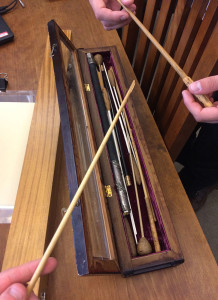
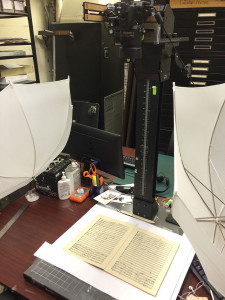
Photos: On left, during a visit to the Archives, I was shown a collection of batons owned by none other than Leonard Bernstein. On right, an interesting process through which the archival team uploads scores to the public online database. This is done through photo (with camera mounted vertically) rather than through scanning or copying.
Not only was I able to work at the New York Philharmonic at Lincoln Center for six weeks, I also lived in one of the greatest cities in the world. Practicing photography, attending concerts outside of the Philharmonic, going to museums like the MET and MoMA, and exploring chic restaurants in the Village occupied my nights and weekends.
I cannot thank the good people at UMS and the New York Philharmonic enough for this wonderful opportunity. The experience will stay with me for a lifetime, and I cannot wait to share its stories with others.
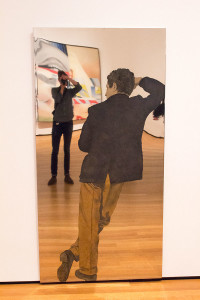
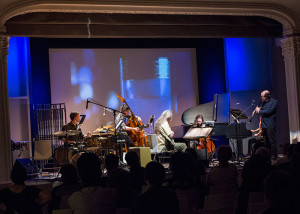
Photos: On left, taken on one of my off days exploring the Museum of Modern Art. On right, one of the great privileges of living in New York City during the early months of summer was the vast number of concerts going on at any one given moment; this was at a performance by Bang on a Can.
The New York Philharmonic returns to Ann Arbor October 9-11, 2015.
Interested in more? Explore New York Philharmonic in our archives.
What are the different kinds of marching bands?
Marching bands are prevalent in modern American society, from ushering in the beginnings of parades to entertaining the masses during football game halftime shows.
Did you know that there are many variations of marching band, each with their own style and traditions? Find out what makes a marching band.
1. The Military Band
The modern marching band originates in the military band tradition. Military bands are characterized by straight, organized ranks that move in the forwards direction. Clean and precise, military bands put a heavy emphasis on the uniformity of their visual style. Military bands often play national or patriotic tunes. The art of the military band isn’t as popular as it was, but some do exist, notably the Texas A&M Fightin’ Texas Aggie Band, the largest military style band in the country. In addition, many United States military bands form marching ranks for particular occasions, such as inaugural parades.
2. The Drum and Bugle Corp
Other styles of marching band borrow elements from the military band, but add their own unique flair. For example, the Drum and Bugle Corps borrows elements of the military’s regimented nature, but make formations that can be more organic and even pictorial. In addition, Drum and Bugle Corps freely move both backwards and forwards. Band members often “traverse” or “slide” so that their upper bodies consistently face the front of the field, ensuring a constant wall of sound no matter what direction they move. These elements can be manipulated to create various effects in dynamics.
Drum and Bugle Corps aim to imitate the artistic sound of a concert band while on the move. These bands put together one show, with a set list of music, based around a theme, which they practice and perform over the length of the season. Their repertoire can vary from classical to jazz to even movie scores. Most bands of this style consist of only brass, percussion, and a color guard, giving them a unique, rich sound due to the absence of the woodwind section.
Drum and Bugle Corps represent the competitive aspect of marching band culture. Many participate in circuits, like Drum Corps International (DCI), where bands compete against one another. Fans of these circuits often loyally support their favorite Drum and Bugle Corps like one would a sports team. Hardcore fans of DCI are known to enter lively debates over which Drum and Bugle Corp is the best of all.
3. The Marching Band
However, probably the most prolific in popular culture is the college marching band, seen performing at halftime at most football games across the United States. These marching bands might put a heavy emphasis on crowd entertainment and sometimes scripted storytelling.
Each band cultivates their own visual style and sound. While some model the Drum and Bugle Corps, others are starkly different, holding true to the regimented tradition of the marching band, but also embracing edgier sounds and contemporary music. All-band dance breaks or the use of props and effects are becoming more common. The repertoire played is catered to the crowd and features popular or radio music. While instrumentation is up to the discretion of the band, most feature full woodwind, brass, drumline, and color guard sections.
In addition, many bands use a high step style either in replacement or addition of the typical roll/glide step seen in Drum and Bugle Corps. This involves band members raising their steps at an angle, though the steps vary based on the traditions of the band.
Details aside, the main goal of these marching bands is to give the audience the best possible experience while anxiously waiting for their football teams to return to the field. One great example is the University of Michigan’s own marching band, The Michigan Marching Band (MMB). From Beyoncé to Willie Wonka to a collaboration with Pixmob, the MMB strives to bring the most innovative in halftime entertainment to the Big House’s 100,000+ crowd every football Saturday. The excitement as the MMB takes the field is palpable for both the musicians and the audience!
4. The Party Band
Lastly, there are many marching bands that exist outside these categories. The Detroit Party Marching Band, for example, carries the spirit of entertainment embraced by many modern marching bands, but with none of the formalities. Jamming to arrangements of popular music, members openly groove and dance as they play. Less attention is placed on the precision of visual style and more is placed on the creation of fun, lighthearted atmosphere. They frequent city streets, standing in a huddle or moving around, ready to start an impromptu party. They capture the spirit of camaraderie and showmanship embraced by the marching band community without the restrictions of the formalities of organized movement. Party bands can perform / party in non-typical venues, and their memorable, laidback attitude draws people to them in flocks.
Do you love marching bands? Are you in a marching band? Share your thoughts and stories in the comments below.
Updated 6/2/2017
A special message from New York Philharmonic to Ann Arbor
Principal Trombone Joseph Alessi on his upcoming visit to Ann Arbor with the New York Philharmonic.
UMS’s Media Roundup
 Many members of the UMS staff keep a watchful eye on local and national media for news about artists on our season, pressing arts issues, and more. We thought we’d pull together a list of interesting stories each week and share them with you. Welcome to UMS’s Media Roundup, a weekly collection of arts news, including national issues, artist updates, local shout-outs, and a link or two just for fun. If you come across something interesting in your own reading, please feel free to share!
Many members of the UMS staff keep a watchful eye on local and national media for news about artists on our season, pressing arts issues, and more. We thought we’d pull together a list of interesting stories each week and share them with you. Welcome to UMS’s Media Roundup, a weekly collection of arts news, including national issues, artist updates, local shout-outs, and a link or two just for fun. If you come across something interesting in your own reading, please feel free to share!
National & International Interest
- Looking for a job? The New York Phil, among other major orchestras, has openings. See what goes into hiring professional orchestra musicians.
- Ever wonder who wrote that incredible piece you heard at the BBC proms on your honeymoon back in 1972? Now you can find out! The BBC Proms just launched a searchable online archive dating back to the first concert in 1895.
- Kennedy Center Director Michael Kaiser is on a mission to turn troubled institutions around.
- Arts trump social causes for donor visibility, but are they losing their cache with a new generation?
- Attention students! Heading to NYC? Check out StudentRush.org, a new website devoted to low-cost (and sometimes free!) admission to cultural events, restaurants, and more around the City.
Artist Updates
- Tony Allen and his band will perform as part of UMS’s 10/11 season on April 16, 2011. The Afrobeat drummer was featured in an NPR story last week about his work with Fela Kuti, and Kuti’s Enduring Legacy.
- Ever wondered what Laurie Anderson really thinks of performance art, and where it’s heading? Salon Magazine has the answers.
- More from Laurie with a discussion of her new album, Homeland, in The Village Voice.
- Nick Eanet, first violinist of the Julliard Quartet resigns. What’s next on his plate and for the ensemble?
- French conductor Ludovic Morlot will replace Gerard Schwartz as music director of the Seattle Symphony next season
Local Shout-Outs
- Congratulations to MOT Director David DiChiera, who recently received a national honor.
- The Detroit International Jazz Festival announced its lineup of local artists as part of the 2010 Festival
- Legendary African-American Choral Director Brazeal Dennard, former Detroit Public Schools Music Supervisor and founder of the Brazeal Dennard Chorale, passes away.
Just For Fun
- A global piano installation hits the Big Apple!











































